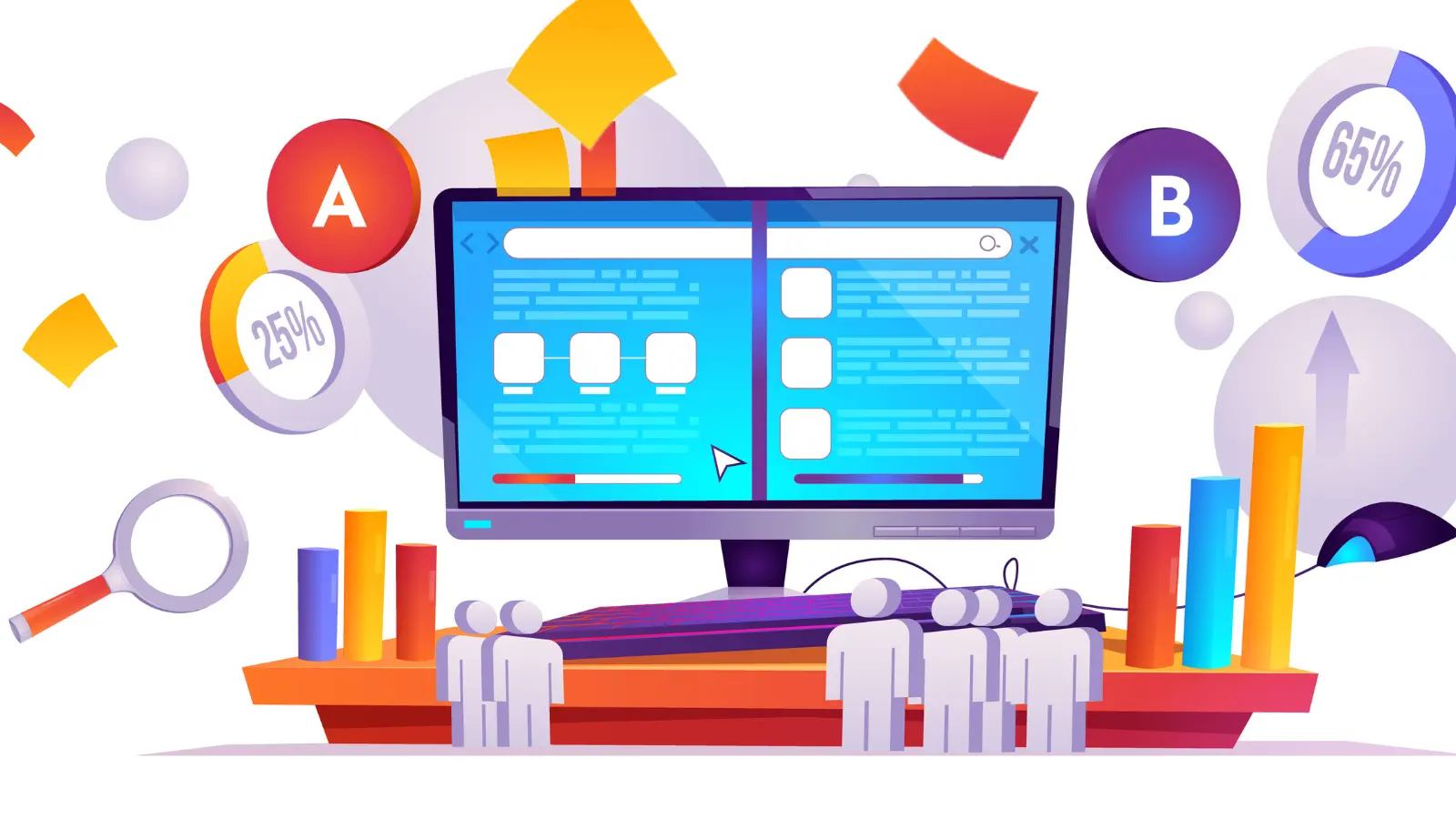

What is A/B Testing? 6 Steps to Successful A/B Testing!
These days, data is everything. Leaders prefer to wait until they have data before making choices.
Naturally, that’s a good thing, and happily, there are many ways to obtain knowledge without having to rely solely on one’s intuition. A/B testing is one of the most popular techniques, especially in online environments.
Keeping the importance of A/B testing in mind, let us have a look at the key concepts related to A/B testing. Read the post to have a thorough understanding of the A/B testing technique.
Let us begin with taking a look at the A/B testing definition.
What Is A/B Testing?
A/B testing, commonly referred to as split testing, is a marketing experiment in which you divide your audience in half to test various campaign iterations and see which one performs best. In other words, you can show one-half of your audience version A of a piece of marketing content while showing the other half version B.
Because different audiences behave, well, differently, A/B testing can be useful. Something that functions well for one business might not always function well for another.
Experts in conversion rate optimization (CRO) despise the term “best practices” because it might not apply to you. But if you’re not careful, this kind of testing might be challenging.
Create a free A/B testing survey to know your the opinion of the respondents
A/B Testing Example
Let us see the A/B Testing for the eCommerce Sector.
Online retailers may raise the average order value, improve their checkout process, lower the rate of cart abandonment, and more using A/B testing.
You might test the following things: the way shipping costs are shown, the location, timing, and manner in which the free shipping option is highlighted, text and color changes on the payment or checkout page, the prominence of reviews or ratings, etc.
Because of the size of its operations and its unwavering commitment to giving customers the best possible experience, Amazon is at the forefront of conversion optimization in the eCommerce sector.
The most well-known of the many ground-breaking techniques they introduced to the eCommerce sector has been their “1-Click Ordering.” 1-Click Ordering, which was introduced in the late 1990s after extensive testing and analysis, enables customers to make purchases without ever using the shopping cart.
Users only need to click the button after entering their default billing card information and delivery address, then they may wait for the requested items to be delivered. When placing an order, users do not need to re-enter their billing and shipping information.
With 1-Click Ordering, it was hard for customers to reject the convenience of the transaction and shop somewhere else.
This modification had such a significant effect on business that Amazon patented it in 1999; the patent has now expired. In order to use it in their online store, Apple really purchased a license for the same in 2000.
Not every adjustment that is made results in an instantaneous “Eureka” moment for those optimizing Amazon’s website. Amazon’s ability to provide the kind of user experience it offers is made possible through ongoing, organized A/B testing.
Every modification to the website is tested first on its target audience before going live. If you were to look at Amazon’s purchasing funnel, you would see that while it largely resembles that of other websites, every component of it is fully optimized and meets audience expectations.
Try it for yourself by creating a A/B testing survey NOW!
What Is The Importance Of A/B Testing?
While B2B companies nowadays complain about the large number of unqualified leads they receive each month, eCommerce firms are having trouble with a high cart abandonment rate.
Meanwhile, low viewer engagement is a problem for both media outlets and publishing organizations. Some typical issues, such as drop-offs on the payment page and leaks in the conversion funnel, have an impact on these key conversion metrics.
Here are some arguments in favor of A/B testing:
Lessen the Bounce rate
The bounce rate of your website is one of the most crucial indicators to monitor while assessing its performance.
Your website’s high bounce rate could be caused by a variety of factors, including an overwhelming amount of alternatives, misaligned expectations, unclear navigation, an excessive amount of technical jargon, and others.
There is no one-size-fits-all method to lower bounce rates because different websites serve different purposes and target different demographics. A/B testing, however, can be advantageous.
Obtain statistically significant gains
You can quickly identify a “winner” and “loser” based on statistically significant improvements in metrics like time spent on the page, number of demo requests, cart abandonment rate, and so on because A/B testing is entirely data-driven and leaves no room for guesswork, gut feelings, or instincts.
Addressing visitor annoyances
Visitors arrive at your website with a specific objective in mind. It can be to learn more about your product or service, purchase a specific item, read/learn more on a certain subject, or just explore.
Poor user experiences result from users not being able to accomplish their objectives. Your conversion rates will eventually suffer as a result of the increased friction.
To alleviate your visitors’ pain points, use information acquired by visitor behavior monitoring tools like heatmaps, Google Analytics, and website surveys.
This holds true for all industries, including publishing, education, travel, SaaS, and e-commerce.
Improve ROI from current traffic
The expense of bringing quality traffic to your website is really high, as the majority of seasoned optimizers have come to understand.
Without having to spend more money on acquiring new traffic, A/B testing enables you to maximize the conversions of your current traffic.
A/B testing helps boost your return on investment since sometimes even the smallest adjustments to your website can result in a big jump in total business conversions.
Create a free A/B testing survey and see its importance for yourself
What Are The Steps Under A/B Testing?
An A/B testing framework that you may use to begin conducting tests is as follows:
Data collection
Your analytics will frequently give you information on where to start optimizing.
To enable you to collect data more quickly, it can be helpful to start with high-traffic regions of your website or app.
Look for pages that can be enhanced that have low conversion rates or high drop-off rates.
Establish goals
The metrics you’ll use to gauge whether the variant is more effective than the original version are known as your conversion goals.
Goals can range from simply clicking a button or link to making a purchase or signing up for emails.
Invent a theory
Once a goal has been established, you can start coming up with A/B testing concepts and reasons why you believe they will be superior to the present version. When you have a list of suggestions, order them according to predicted impact and implementation difficulties.
Develop variants
Change the desired aspect of your website or mobile app experience using your A/B testing tools. This could be done by altering the color of a button, rearranging the page’s elements, hiding the navigation, or doing something else entirely.
Run the experiment
At this point, users of your website or app will be randomized at random to either the control experience or a variation of it. To ascertain how each performs, their engagement with each encounter is quantified, counted, and contrasted.
Analyze outcomes
Analyzing the outcomes of your experiment is the next step. Your A/B testing program will present the experiment’s data, show you how the two versions of your page performed differently, and determine whether there is a statistically significant difference between them.
Conclusion
Now that you’ve read this in-depth article on A/B testing, you should be well-prepared to create your own optimization roadmap. If you don’t give data the importance it deserves, you run the risk of making both significant and tiny mistakes.
Therefore, carefully follow each step involved. When it comes to increasing the conversion rates of your website, A/B testing is crucial.
A/B testing can significantly lower the risks associated with launching an optimization program if it is carried out with great dedication and using the knowledge you already possess.
Happy testing!
FAQs
Why do companies use A/B testing?
A/B testing is used by more than 75% of companies to find problems with their websites’ design, typography, and other elements.
Exposing the reasons why customers quit their carts, helps to decrease cart abandonment. There may be a number of causes, including bad layout, unstated costs, etc.
Is AB testing the same as hypothesis testing?
A/B testing follows the same steps as the hypothesis testing process. To comprehend what is happening and decide which feature needs to be tested, analysts must first do some preliminary study.







